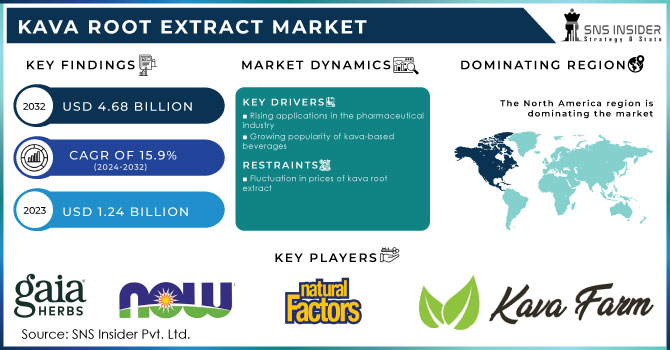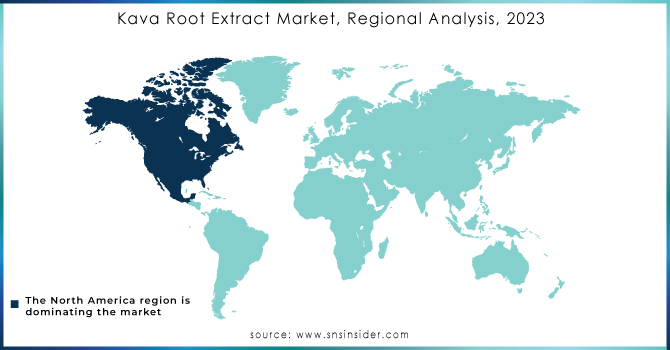Kava Root Extract Market Report Scope & Overview:

Get More Information on Kava Root Extract Market - Request Sample Report
The Kava Root Extract Market size was USD 1.24 billion in 2023 and is expected to Reach USD 4.68 billion by 2032 and grow at a CAGR of 15.9 % over the forecast period of 2024-2032.
Kava is a plant-based beverage or extract derived from the Piper methysticum plant. It's a popular drink in the South Pacific, where it's utilized in relaxing ceremonies. Due to its anti-inflammatory, analgesic, and anxiolytic characteristics, kava root extract is utilized as an ingredient in a variety of food products, including beverages, baked products, and confectionery. In addition, due to the therapeutic properties of kava root extract, it is also included in many pharmaceutical and health products.
Kava root powder extract is an organic flavoring agent. It is non-toxic and harmless in nature. The present commercial product was created by extracting and fractionating "Kavalactone," an active component found in kava.
By product type, the kava root powder extract accounts for a market value of USD 352.4 million in 2022 this is attributed to easy availability and ease of utilization. It is often consumed in the form of tea which is good for weight loss, enhanced immunity, and digestion. Due to its euphoric effects and lack of caffeine, which lowers stress levels, the popularity of kava is rising among people as a substitute for normal tea. Also, it has wide applications in dietary supplements and personal care sectors which drive the growth.
Kava Root Liquid Extract is also witnessing growth in the food and beverages sector as it is used to enhance its nutritional value.
MARKET DYNAMICS
KEY DRIVERS
-
Rising applications in the pharmaceutical industry
Kava root extract is being investigated as a potential material for treating anxiety disorders. Several studies have shown that it can be as effective as conventional anti-anxiety medications, such as benzodiazepines, with fewer side effects. Also, Kava root extract can be used as a natural sleep aid and It can be used to relieve pain caused by a variety of conditions, such as headaches, muscle pain, and arthritis. Therefore, kava extract has a rising demand in the pharmaceutical industry.
-
Growing popularity of kava-based beverages
RESTRAIN
-
Fluctuation in prices of kava root extract
The price of kava root extract is affected by several factors, including the supply and demand of kava root, the cost of handling, production, and the regulatory environment. The price of kava root extract can also be affected by the availability of substitutes. If other products can be used to achieve the same benefits as kava root extract, then the price of kava root extract will be lower.
OPPORTUNITY
-
Increased research on the health benefits of kava root extract
Kava includes biologically active kalvactones that have the highest medicinal properties and are extracted with organic solvents. Kava is mostly used as an herbal supplement, and its popularity has grown in tandem with its increased availability in health food stores and through internet outlets. Kava can generate non-narcotic anesthetic effects by inducing skeletal muscle relaxation without causing depression in the Central Nervous System. As a result, an increasing number of clinical trials and research are being conducted to investigate the role of kava in cancer prevention and therapy.
-
Expansion of the market in an untapped market
CHALLENGES
-
Side effects of kava root extract
The kava root extract adverse effects may stymie the kava root extract business. This is due to the fact that some people may be hesitant to consume kava root extract if they are aware of the potential side effects. Drowsiness, dizziness, headache, rash, allergic response, and upset stomach are all possible symptoms. Companies that sell kava root extract products must be open and honest about the potential negative effects of kava root extract and ensure that consumers are informed of the dangers before taking kava root extract.
IMPACT OF RUSSIA-UKRAINE WAR
The market for kava root extract is significantly being impacted by the Russia-Ukraine conflict. The South Pacific islands are home to the kava plant, and Fiji and Vanuatu are the two nations that generate the most kava root extract. Both countries are heavily dependent on exports of kava root extract but the war has disrupted supply networks. Many people are turning to kava as a natural approach to reducing stress and anxiety, which are regular aftereffects of conflict. Supply networks have been hampered by the war which has led to an increase in the prices of kava root extract.
IMPACT OF ONGOING RECESSION
The impact of a recession on the kava root extract market is difficult to predict. The rise in the price of kava root extract has lowered the demand in the pharmaceutical and cosmetic sectors. Among end-user’s Pharmaceutical sector was the major market constituting approximately 21 % of the market share in 2022 which is declining due to the surge in prices of kava root extract used in medicine. Manufacturers may search for an alternative option to kava root which has the same functional properties.
MARKET SEGMENTATION
by Type
-
Kava Root Powder Extract
-
Kava Root Liquid Extract
by End-User
-
Individuals
-
Pharmaceuticals
-
Food & Beverages
-
cosmetics
-
Personal care products
REGIONAL ANALYSIS
North America is expected to register significant revenue growth in the forecasting period this is attributed to the rising demand for kava root extract as a non-alcoholic beverage. Additionally, the current legislation that permits the import of kava into Australia will benefit the sector.
Europe is anticipated to account for a sizable revenue share in the global market owing to the rapidly expanding use of kava root extract in pharmacology clinical studies highlighting the therapeutic benefits of kava root extracts. Also, Rising consumer preference towards healthy beverages such as kava tea.
Asia Pacific is predicted to have robust revenue CAGR due to the increased use of kava root extract in personal care products, the popularity of kava tea as a non-alcoholic beverage, and the expansion of the pharmaceutical industry in the region.
Fiji is located in the South Pacific Ocean's Melanesia subregion of Oceania. The majority of the world's kava root extract is produced and exported by Fiji. Kava root extract has long been used throughout the nation for traditional medical treatments. There are several conditions that can be treated with kava root extract, such as stress, sleeplessness, and anxiety. The private sector is pondering upon kava anti-anxiety medicines and nurseries to promote its consumption and plantation. Over 20,000kg of kava were imported into Australia from Fiji in June 2022, whereas less than 15,000kg were noted in July, according to the Fiji Consulate General & Trade Commission report
Vanuatu is also a major exporter of kava root extract. The export industry is being driven by the rising demand for kava root extract in the global market. Vanuatu has employed kava root extract as a traditional remedy for several illnesses for generations. The recent surge in kava bars in the United States serves as an example.

Need any customization research on Kava Root Extract Market - Enquiry Now
REGIONAL COVERAGE
North America
-
US
-
Canada
-
Mexico
Europe
-
Eastern Europe
-
Poland
-
Romania
-
Hungary
-
Turkey
-
Rest of Eastern Europe
-
-
Western Europe
-
Germany
-
France
-
UK
-
Italy
-
Spain
-
Netherlands
-
Switzerland
-
Austria
-
Rest of Western Europe
-
Asia Pacific
-
China
-
India
-
Japan
-
South Korea
-
Vietnam
-
Singapore
-
Australia
-
Rest of Asia Pacific
Middle East & Africa
-
Middle East
-
UAE
-
Egypt
-
Saudi Arabia
-
Qatar
-
Rest of Middle East
-
-
Africa
-
Nigeria
-
South Africa
-
Rest of Africa
-
Latin America
-
Brazil
-
Argentina
-
Colombia
-
Rest of Latin America
KEY PLAYERS
Some major key players in the kava root extract Market are NOW Foods, Botanica, Gaia Herbs, Taos Herb Company, Botanica, Bolise Co. Ltd, CuraScientific, Natural Factors, Best Nutrition Product, Kona Kava Farm, Kava King Products, Best Nutrition Products, Inc., Root of Happiness, and Nutragreenlife Biotechnology, Co. Ltd., and other key players.
RECENT DEVELOPMENTS
In 2023 CuraScientific manufactures its kava extract while proposing a $150 million expansion of its kava market. Over the following five years, the business plans to build 30 Kava Bars and sell kava extract for $150 million.
| Report Attributes | Details |
| Market Size in 2023 | USD 1.24 Billion |
| Market Size by 2032 | USD 4.68 Billion |
| CAGR | CAGR of 15.9 % From 2024 to 2032 |
| Base Year | 2022 |
| Forecast Period | 2024-2032 |
| Historical Data | 2020-2022 |
| Report Scope & Coverage | Market Size, Segments Analysis, Competitive Landscape, Regional Analysis, DROC & SWOT Analysis, Forecast Outlook |
| Key Segments | • By Type (Kava Root Powder Extract, Kava Root Liquid Extract) • By End-User (Individuals, Pharmaceuticals, Food & Beverages, and cosmetics and Personal care products) |
| Regional Analysis/Coverage | North America (US, Canada, Mexico), Europe (Eastern Europe [Poland, Romania, Hungary, Turkey, Rest of Eastern Europe] Western Europe] Germany, France, UK, Italy, Spain, Netherlands, Switzerland, Austria, Rest of Western Europe]), Asia Pacific (China, India, Japan, South Korea, Vietnam, Singapore, Australia, Rest of Asia Pacific), Middle East & Africa (Middle East [UAE, Egypt, Saudi Arabia, Qatar, Rest of Middle East], Africa [Nigeria, South Africa, Rest of Africa], Latin America (Brazil, Argentina, Colombia Rest of Latin America) |
| Company Profiles | NOW Foods, Botanica, Gaia Herbs, Taos Herb Company, Botanica, Bolise Co. Ltd, CuraScientific, Natural Factors, Best Nutrition Product, Kona Kava Farm, Kava King Products, Best Nutrition Products, Inc., Root of Happiness, and Nutragreenlife Biotechnology, Co. Ltd. |
| Key Drivers | • Rising applications in the pharmaceutical industry • Growing popularity of kava-based beverages |
| Market Opportunity | • Increased research on the health benefits of kava root extract • Expansion of the market in an untapped market |

